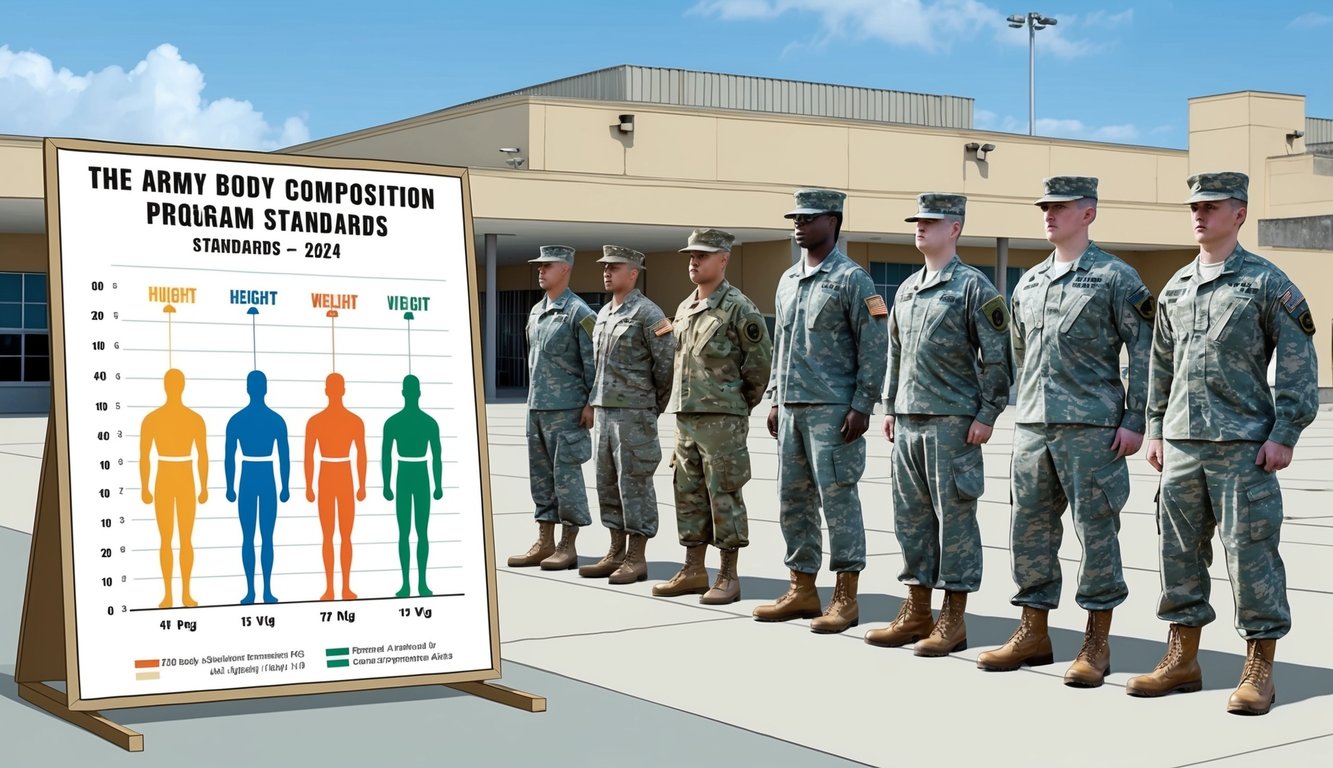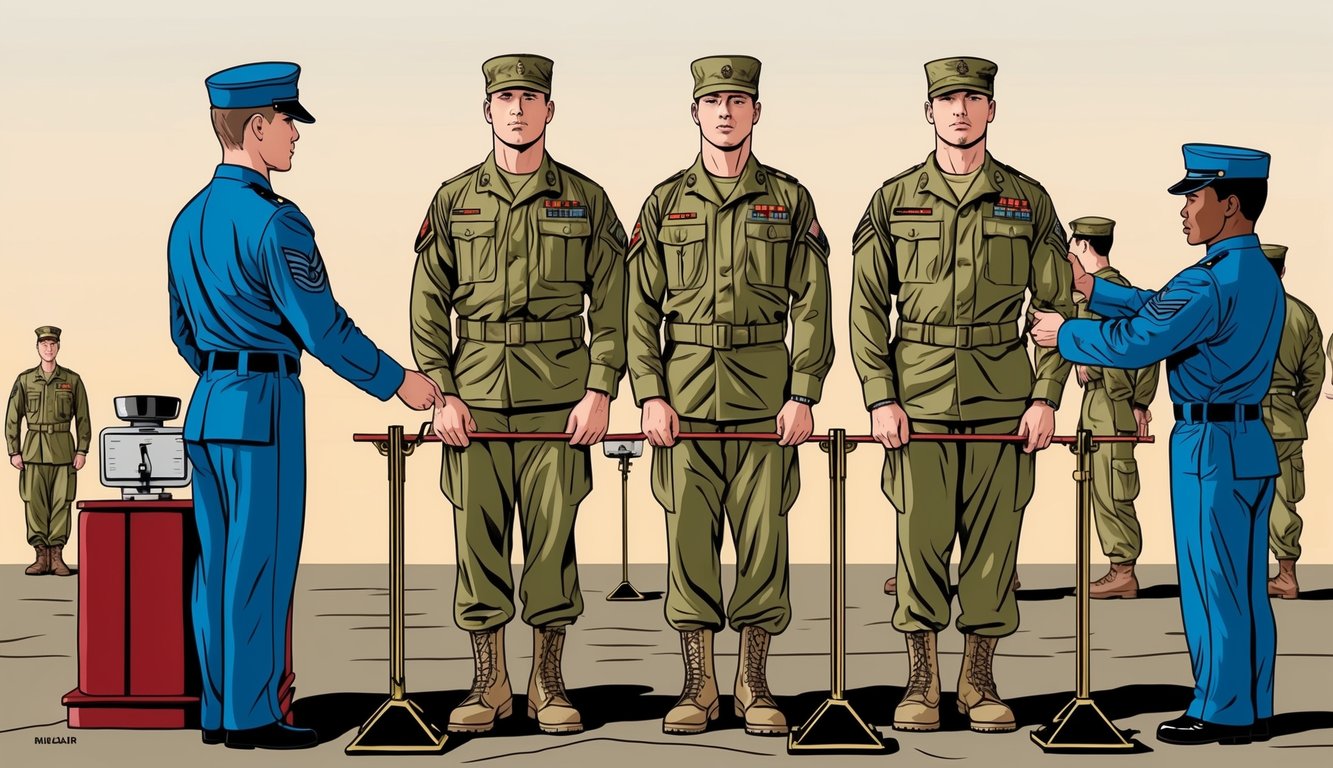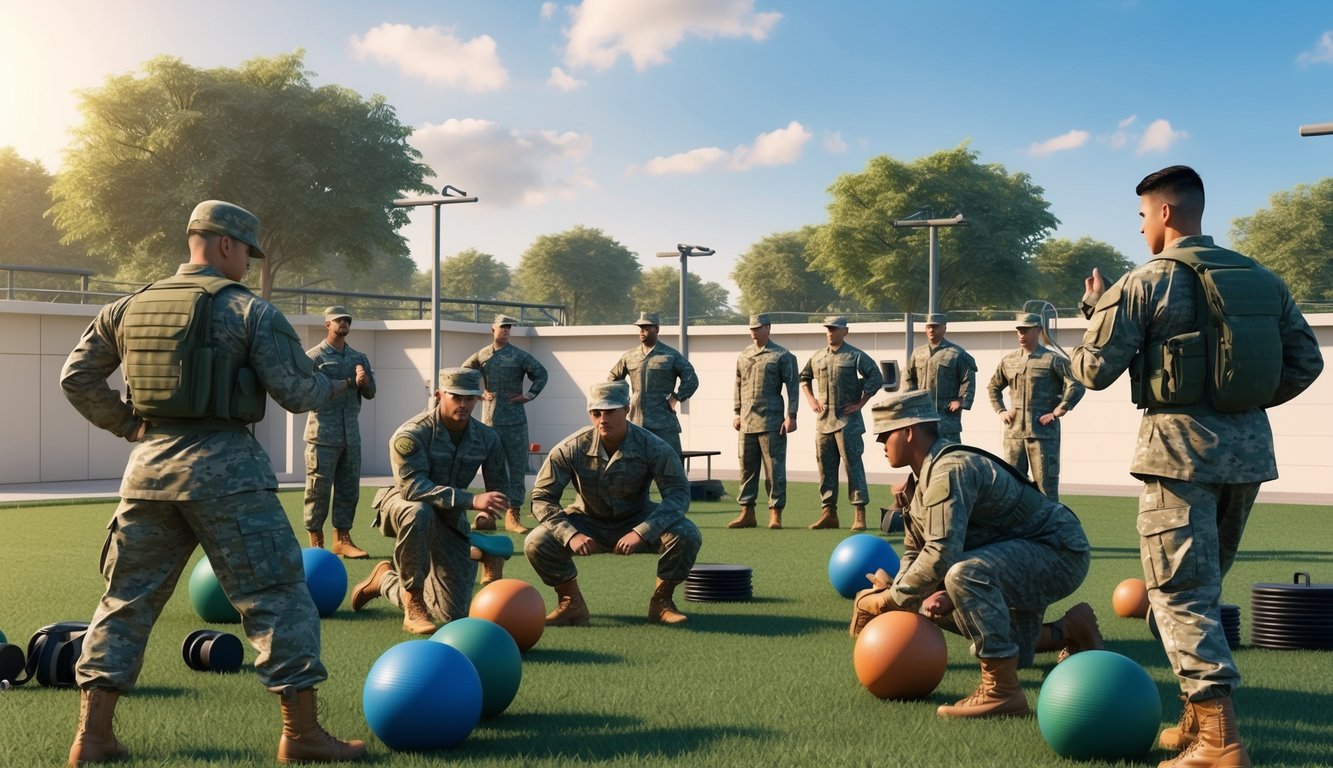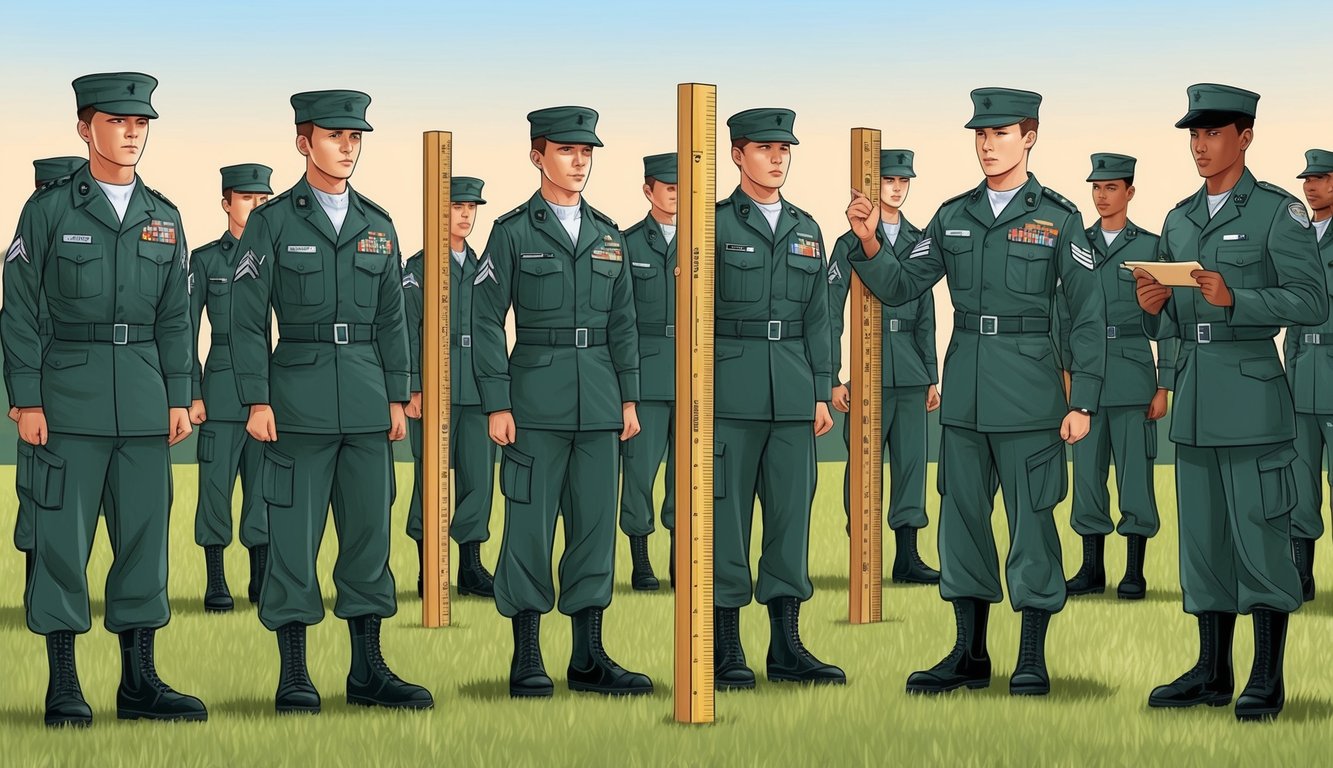The U.S. Army upholds rigorous height and weight standards to maintain the readiness and effectiveness of its personnel.
As a current soldier or prospective recruit, it is essential to understand these requirements, which have been revised for 2024. Beginning June 9, 2024, the Army will implement a one-site circumference-based tape method for measuring body composition.
Adhering to these standards is vital for your military career.
Whether you’re contemplating enlistment or are already active, meeting these criteria is necessary for promotions, special assignments, and overall success in the military.
The Army’s emphasis on physical fitness transcends mere numbers; it aims to cultivate a force equipped to handle the demanding physical challenges inherent in military service.
The Army’s fitness strategy has progressed, adopting new evaluation techniques and a broader understanding of health.
The Army Combat Fitness Test (ACFT) plays a critical role in evaluating overall physical readiness, complementing the height and weight standards.
Grasping these requirements and their relevance to Army fitness is key to thriving in your military career.
Key Takeaways
- The Army adopts a one-site tape method for body composition measurement as of June 2024
- Height and weight standards are essential for enlistment, promotions, and career advancement
- The Army Combat Fitness Test supports body composition standards in evaluating overall readiness
Understanding Army Height and Weight Standards
The Army’s height and weight standards ensure that soldiers maintain optimal physical fitness and combat readiness.
These standards vary by age and gender, addressing the diverse needs of its service members.
The Importance of Health and Fitness in the Army
Physical fitness is vital for military effectiveness.
The Army’s standards promote overall health, enhance job performance, and lower the risk of injuries.
These guidelines are designed to help you maintain physical fitness, which is crucial for handling heavy equipment and executing demanding tasks.
Regular fitness assessments are vital for preparing for the physical demands of military life.
Achieving these standards reflects your commitment and discipline, essential traits for success in the Army.
Current Standards for Men and Women
The Army employs height-weight tables to evaluate initial fitness.
If your weight exceeds the limit for your height, a body fat percentage measurement will follow.
For men, the maximum body fat percentage ranges from 20% to 26%, depending on age.
In contrast, women’s limits fall between 30% and 36%.
Here’s a quick reference for some common heights:
| Height (inches) | Max Weight Men (lbs) | Max Weight Women (lbs) |
|---|---|---|
| 68 | 180 | 163 |
| 70 | 190 | 169 |
| 72 | 200 | 175 |
Age Group Variances
The Army acknowledges that body composition changes with age, and therefore adjusts standards accordingly to ensure fairness and efficiency.
For example, a 21-year-old male soldier has stricter body fat limits than a 40-year-old counterpart.
This ensures realistic expectations while sustaining force readiness.
Age groups typically span 5-year intervals, with slight increases in allowable body fat percentages for each group.
This framework helps you understand what is expected as you advance in your military career.
Enlistment and Basic Training Requirements
Adhering to Army height and weight standards is essential for enlistment and successfully completing basic training.
These criteria ensure that recruits are physically fit and capable of handling the rigors of military service.
Initial Height and Weight Screening
Upon considering joining the Army, an initial height and weight screening will be conducted.
This usually occurs at a Military Entrance Processing Station (MEPS).
The process measures your height and weight to ascertain whether you fall within the acceptable range for your age and gender.
Minimum height requirements for men are 60 inches (5 feet) and a maximum of 80 inches (6 feet 8 inches).
Women have a minimum height of 58 inches (4 feet 10 inches) with the same maximum height as men.
Your weight should align with your height according to the Army’s chart.
Meeting the Standards for Recruits
To enlist, specific height and weight criteria based on your age group must be met.
The Army utilizes a Body Mass Index (BMI) chart to determine your compliance within the acceptable range.
If your weight exceeds the maximum for your height, you may still qualify if your body fat percentage falls within permissible limits.
Here’s a simplified example of weight standards for men aged 17-20:
- 68 inches tall: 132-178 pounds
- 72 inches tall: 144-194 pounds
Remember, these standards are just the starting point.
Maintaining your fitness throughout basic training and your entire Army career is crucial.
Regular physical fitness tests and weigh-ins will be part of your routine to ensure ongoing compliance with required standards.
Regular Assessments and Army Body Composition Program

The Army enforces strict standards regarding soldier fitness and body composition.
These requirements promote combat readiness and support the overall health of the force.
Routine Screening and Weight Assessments
Regular height and weight screenings form part of your military service.
These assessments generally occur every six months or during specific events such as promotions or specialized schools.
Initial screenings in your unit will use the weight-for-height table.
If you exceed the maximum allowable weight, a one-site tape test will be conducted to measure your abdominal circumference, which estimates your body fat percentage.
This method will take effect as of June 9, 2024.
The Army Combat Fitness Test score can allow exceptions to body fat standards in certain cases.
This provision enables physically fit soldiers who may not meet tape test standards to remain compliant.
Consequences of Failing to Meet Standards
Non-compliance with Army body composition standards can adversely affect your military career.
Failure to pass the initial screening and subsequent tape test results in enrollment in the Army Body Composition Program (ABCP).
While in the ABCP, you will receive nutrition counseling and be required to engage in additional physical training.
Your progress will be monitored closely through regular weigh-ins and assessments.
Continued failure to meet standards could lead to administrative actions, including:
- Negative performance evaluations
- Ineligibility for promotions or specialized schools
- Potential separation from the Army
It is vital to maintain your fitness and body composition to avoid these repercussions and ensure you remain duty-ready.
Evaluation Methods and Alternatives

The Army employs various methods to assess soldiers’ body composition and physical fitness.
These range from traditional measurements to advanced technologies, providing a comprehensive analysis of your overall health and readiness.
Traditional Tape Test Method
The tape test remains a fundamental method for assessing body composition.
The Army will implement a one-site (abdomen) circumference-based tape method as of June 2024.
This streamlined approach focuses on measuring your abdominal circumference to estimate body fat percentage.
During the test, a measuring tape is positioned around your abdomen at the level of the navel.
The measurement is taken after a normal exhale.
This method is quick, cost-effective, and does not necessitate specialized equipment.
If you do not pass the initial one-site tape test, you may qualify for a follow-up confirmation test using the previous multiple-site method for up to 12 months from the date of Army Directive 2023-11.
Supplemental Body Fat Assessment Tools
When greater accuracy is required, the Army utilizes supplemental body fat assessment tools for a more detailed analysis of your body composition.
Approved tools include:
- InBody 770: A bioelectrical impedance device that evaluates body water, muscle mass, and fat mass.
- BOD POD: Utilizes air displacement plethysmography to determine body density and estimate fat percentage.
- Dual X-ray Absorptiometry (DXA): Provides precise measurements of bone density, fat mass, and lean tissue.
These tools offer an in-depth perspective on your body composition, identifying potential areas for improvement in your fitness regime.
Emerging Technologies and Techniques
The Army is continually exploring new technologies and techniques for assessing body composition and overall fitness, aiming for more accurate and comprehensive evaluations.
One such innovation is 3D body scanning, which generates a detailed digital model of your physique, enabling precise measurements and analysis of body composition.
Wearable fitness trackers are also gaining traction, monitoring various health metrics over time to provide a thorough overview of your fitness level and progress.
Additionally, the Army is investigating AI-powered assessment tools that analyze multiple data points for a clearer picture of your overall health and readiness.
The Army Combat Fitness Test (ACFT)
The ACFT evaluates soldiers’ combat readiness through a series of physical challenges and is essential in assessing overall fitness while influencing height and weight standards.
How ACFT Assessments Integrate with Height and Weight Standards
The ACFT and body composition criteria work in tandem to evaluate your physical fitness.
The test consists of six events: 3-repetition maximum deadlift, standing power throw, hand-release push-ups, sprint-drag-carry, leg tuck or plank, and a 2-mile run.
Your ACFT score can affect height and weight requirements.
Scoring 540 points or above grants exemption from body fat assessments, regardless of your height and weight.
This exemption acknowledges that high performers may have different body compositions.
To successfully pass the ACFT, you need a minimum of 60 points in each event, culminating in a total of 360 points.
The maximum score achievable is 600 points, with age and gender-specific standards ensuring fairness across demographics.
Keep in mind, your ACFT score is indicative of your combat readiness.
It’s not merely about passing — achieving higher scores demonstrates superior physical preparedness for military responsibilities.
Holistic Health and Fitness Program

The Army’s Holistic Health and Fitness (H2F) program takes an all-encompassing approach to soldier wellness, focusing on five key domains to enhance overall readiness and performance.
A Comprehensive Approach to Soldier Fitness
H2F targets your physical readiness, nutritional habits, mental resilience, spiritual wellness, and sleep quality.
This integrated strategy is designed to boost your fitness level and body composition.
The program provides resources to assist you in achieving and maintaining a healthy weight, offering expert guidance on nutrition and hydration essential for muscle growth and recovery.
H2F teams are rapidly expanding across Army units, consisting of fitness trainers, dietitians, and mental health professionals dedicated to assisting your wellness journey.
H2F facilities are equipped with state-of-the-art exercise equipment and tools for body fat assessment.
These centers offer personalized plans to help you align with Army height and weight standards.
The program additionally emphasizes injury prevention and rehabilitation, teaching you techniques to safeguard your body during physical training and combat scenarios.
Navigating Career Impacts and Advancement Challenges
Adhering to height and weight requirements is critical for your military career, influencing promotions, assignments, and overall readiness.
Career Progression and Fitness Standards
In the Army, physical fitness affects your career growth directly.
Failing to meet height and weight standards can result in lost promotion opportunities.
Non-compliance may also restrict access to certain specialized roles or leadership positions.
Regular weigh-ins and fitness assessments are an integral part of your military experience.
Surpassing weight limits may lead to enrollment in the Army Body Composition Program, impacting your performance evaluations and narrowing career options.
Maintaining fitness standards signifies commitment and discipline, attributes valued in leadership roles.
Compliance with these requirements paves the way for advanced training and prestigious assignments.
Strategies for Maintaining Compliant Body Metrics
To align with Army standards, prioritize a balanced diet and regular exercise.
Incorporate strength training to develop muscle mass, which aids in managing body fat percentage.
Consider collaborating with a nutritionist to create a meal plan suited to your specific needs.
Stay hydrated, and aim for consistent, moderate workouts rather than extreme training regimens.
Regularly track your progress using the Army’s measurement methods.
This proactive approach aids in avoiding potential issues.
If you encounter difficulties, seek assistance from your unit’s fitness resources.
Above all, these standards exist to ensure combat readiness.
By maintaining your fitness, you not only advance your career but also contribute to the overall preparedness of the force.
Frequently Asked Questions
The Army has revised its height and weight standards for 2024, introducing changes to measurement techniques and body composition assessments.
These alterations aim to ensure a more accurate evaluation of soldiers’ fitness levels.
How can I calculate my height and weight adherence for the Army’s updated 2024 rules?
To establish if you meet the Army’s updated standards, compare your height and weight against the official charts.
If your weight exceeds the height limit, you will be subjected to a tape test.
The Army will utilize a one-site (abdomen) circumference-based tape method as the latest approach, replacing previous multi-site evaluations.
What are the latest body fat percentage standards for Army personnel?
The Army has specific body fat percentage limits based on age and gender to ensure soldiers uphold a fitness level appropriate for military service.
Exact percentages vary, so it is recommended to consult the most recent AR 600-9 regulation pertaining to your age group and gender.
These standards are periodically updated to reflect contemporary health research.
Where can I find the updated Army height and weight charts for males and females?
The latest Army height and weight charts can be accessed through AR 600-9, the official regulation governing the Army Body Composition Program.
This document is available on the Army Publishing Directorate website.
The charts list maximum allowable weights based on height for both male and female soldiers and are regularly revised to align with current health and fitness standards.
Can you explain the updated tape test procedures for the Army as per AR 600-9?
The new tape test centers on a single-site measurement of the abdomen, replacing the previous multi-site method.
This test requires measuring tape to be placed around your abdomen at the navel level, with the measurement taken after a normal exhale.
In 2024, what is the margin of error allowed by the Army for height and weight measurements?
The Army permits a minor margin of error in height and weight measurements to account for possible variances in measuring equipment or techniques.
For height, the margin is typically 1/2 inch, while weight measurements allow for a 1-pound tolerance.
Always refer to the most recent regulations for accurate figures.
What are the new age-specific height and weight requirements for enlisting in the Army?
The Army’s enlistment standards consider both age and gender, with requirements varying for active duty, Reserve, and National Guard components.
To find age-related height and weight requirements, consult a recruiter or review the latest edition of AR 40-501, which outlines medical standards for enlistment, including height and weight criteria.

